| Issue
Date |
24.05.1995 |
| ID |
Michel: 789-792, Bl.
22 Scott: Stanley
Gibbons: Yvert: UPU: N/A
Category: pF |
| Author |
L. Kreidemann |
| Stamps in set |
5 (4 + Block) |
| Value |
40 c.,
Geochelone stromeri,
80 c., Diamantornis wardi (eggs),
90 c.,
Prohyrax hendeyi (skull),
1.20 N$., Crocodylus lloydi
(skull),
Block, 80 c., Diamantornis wardi |
| Size (width x
height) |
|
| Layout |
|
| Products |
FDC x2 |
| Paper |
|
| Perforation |
13.75 x 14.25 |
| Print Technique |
Offset |
| Printed by |
|
| Quantity |
|
| Issuing Authority |
|
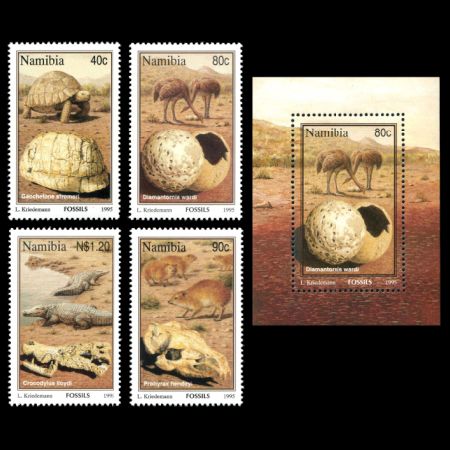
In May 1995 Post Authority of Namibia issued a set
of four stamps and a block depicting some fossil of prehistoric animals and some
modern animals of the country. All this fossils are found at Orange
River. (Orange River is the longest river in South Africa. It rises in the
Drakensberg mountains in Lesotho, flowing westwards through South Africa to the
Atlantic Ocean. The river forms part of the international borders between South
Africa and Namibia and between South Africa and Lesotho, as well as several
provincial borders within South Africa. Except for Upington, Kimberly, and
Aggeneys, the river does not pass through any major cities, it plays an
important role in the South African economy by providing water for irrigation,
as well as hydroelectric power. The river was named by Robert Jacob Gordon after
the Dutch Royal House.) The fossils of the
Orange River vlley provide us with a rare glimpse of life in southern Namibia
between 20 and 16 million years ago.
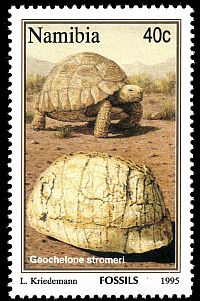 40c Geochelone stromeri 40c Geochelone stromeri
In the Lower
Miocene period 19 to 20 million years ago, the coastal region of southern
Namibia was inhabited by giant tortoises, first described in 1926 as
Geochelone stromeri. In 1992, the first complete carapaces of this species
were found during diamond mining operations at Auchas in the Orange River
valley 50 kilometres upstream from Oranjemund. The tortoises are
associated with fossil mammals and plants that indicate that the area
enjoyed a subtropical climate at the
time that they lived, in
stark contrast to the extremely arid conditions that prevail there
today. The specimen depicting on the stamp is almost half a metre long and
25 centimetres high, an is thus much larger than any tortoise living in
southern Namibia today.
|
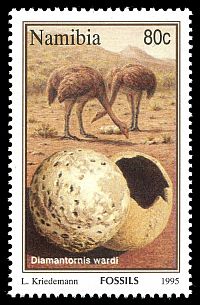 80c Diamantornis wardi 80c Diamantornis wardi
Fossilised eggsehll
fragments have been known to occur in the Sperrgebiet (forbidden
territory) for many years, but it was only in 1992 that the first complete
eggs were foun y the Namibia Palaeontology Expedition at Ftooilepel. At
this site 30 kilometres north of Auchas Mine is an extensive cliff of
hardened sand dunes 120 metres thick which contain abundant fossil mammals
as well as eggshells dating from about 16 to 17 million years ago. The
eggs of Diamantornis wardi (Wards
Diamod Bird) are one and a half times
as voluminous as those of the living ostrich (1,8 liters as opposed to 1,2
litres) and the shell is much thicker (3 to 4 millimetres verus 1,2
millimetres), suggesting that the birds that laid them were appreciably
larger than the living ostrich.
|
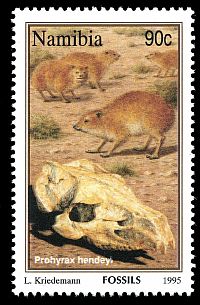 90c Prohyrax hendeyi 90c Prohyrax hendeyi
At Arrisdrift, 35
kilometres upstream from Oranjemund, numerous fossils were found in an
abandoned channel of the Orange River during diamond prospecting
activities. The commonest mammals found at the site, dating from 17,5
million years ago, were large dassies (hyraxes) the size of Dorper sheep.
In 1976, a particularly finely preserved skull was found and this formed
the basis for the reconstruction depicting on the stamp. These dassies
probably lived in herds along the floodplain of the proto-Orange River,
much as the springbok today. At that time, the environment in the Orange
River valley would have been considerably more luxuriant than it is today.
Apart from dassies, Arrisdrift has yielded many other species of mammals
ranging in size from mice to elephants.
|
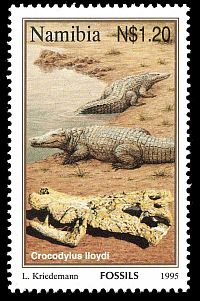 N$1,20 Crocodylus lloydi N$1,20 Crocodylus lloydi
In
contrast to the arid situation prevailing today in the lower Orange River
valley, the environment was probably subtropical and the vegetation more
luxuriant during the Middle Miocene period 17,5 million years ago. At
Arrisdrift, many fossilised crocodile bones and teeth have been excavated
which indicate that the climate was on average warmer then than it is now.
The discovery of the complete skull and jaws of the Crocodylus I/oydi
revealed its similarity in shape and size to the Nile crocodile, the
modern distribution of which is restricted to the tropics and subtropics.
Many of the fossil mammal bones at Arrisdrift show evidence of having been
bitten by crocodile, which must have been one of the major predators in
the valley.
|
Commemorative envelope:
Orangemeryx
hendeyiDuring the Middle Miocene period, an incredible variety of
now extinct mammals comprising at least 28 species lived in the proto-Orange
River valley. One of the most peculiar of these was a large ruminant about the
size of a gemsbok, called Orangemeryx hendeyi. It belonged to the giraffoid
group and possessed branched ossicones (antlerlike horns) covered in skin. It
was probably a browser, preferring young shoots and leaves out of reach to other
herbivores but which it could exploit because of its long legs and neck. Many of
the Orangemeryx fossils have tooth marks made by
crocodile.
Products
| FDC (inside text of
the FDC is here) | |
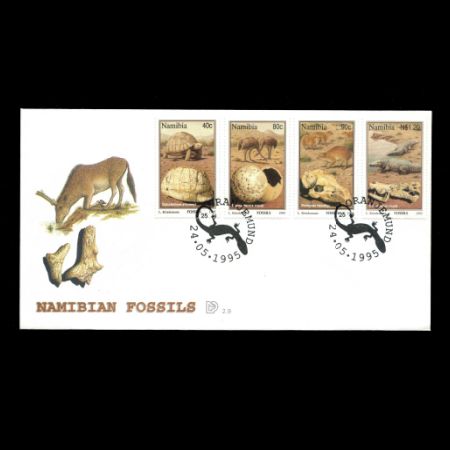
|  |
References:
inside text of the FDC
Last update 19.11.2017
Any feedback, comments or even complaints
are welcome: [email protected] (you
can email me on ENglish, DEutsch, or RUssian)







